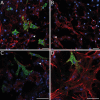Secreted frizzled related protein is a target of PaxB and plays a role in aquiferous system development in the freshwater sponge, Ephydatia muelleri
- PMID: 30794564
- PMCID: PMC6386478
- DOI: 10.1371/journal.pone.0212005
Secreted frizzled related protein is a target of PaxB and plays a role in aquiferous system development in the freshwater sponge, Ephydatia muelleri
Abstract
Canonical and non-canonical Wnt signaling, as well as the Pax/Six gene network, are involved in patterning the freshwater sponge aquiferous system. Using computational approaches to identify transcription factor binding motifs in a freshwater sponge genome, we located putative PaxB binding sites near a Secreted Frizzled Related Protein (SFRP) gene in Ephydatia muelleri. EmSFRP is expressed throughout development, but with highest levels in juvenile sponges. In situ hybridization and antibody staining show EmSFRP expression throughout the pinacoderm and choanoderm in a subpopulation of amoeboid cells that may be differentiating archeocytes. Knockdown of EmSFRP leads to ectopic oscula formation during development, suggesting that EmSFRP acts as an antagonist of Wnt signaling in E. muelleri. Our findings support a hypothesis that regulation of the Wnt pathway by the Pax/Six network as well as the role of Wnt signaling in body plan morphogenesis was established before sponges diverged from the rest of the metazoans.
Conflict of interest statement
The authors have declared that no competing interests exist.
Figures







Similar articles
-
ROCK inhibition abolishes the establishment of the aquiferous system in Ephydatia muelleri (Porifera, Demospongiae).Dev Biol. 2016 Apr 15;412(2):298-310. doi: 10.1016/j.ydbio.2016.02.026. Epub 2016 Mar 2. Dev Biol. 2016. PMID: 26944094
-
The evolution and function of the Pax/Six regulatory network in sponges.Evol Dev. 2013 May;15(3):186-96. doi: 10.1111/ede.12032. Evol Dev. 2013. PMID: 23607302
-
Retinoic acid down-regulates the expression of EmH-3 homeobox-containing gene in the freshwater sponge Ephydatia muelleri.Mech Ageing Dev. 2001 Jun;122(8):779-94. doi: 10.1016/s0047-6374(01)00235-4. Mech Ageing Dev. 2001. PMID: 11337008
-
The stem cell system in demosponges: insights into the origin of somatic stem cells.Dev Growth Differ. 2010 Jan;52(1):1-14. doi: 10.1111/j.1440-169X.2009.01162.x. Dev Growth Differ. 2010. PMID: 20078651 Review.
-
From traveler to homebody: Which signaling mechanisms sponge larvae use to become adult sponges?Adv Protein Chem Struct Biol. 2019;116:421-449. doi: 10.1016/bs.apcsb.2019.02.002. Epub 2019 Mar 14. Adv Protein Chem Struct Biol. 2019. PMID: 31036299 Review.
Cited by
-
Freshwater sponge hosts and their green algae symbionts: a tractable model to understand intracellular symbiosis.PeerJ. 2021 Feb 11;9:e10654. doi: 10.7717/peerj.10654. eCollection 2021. PeerJ. 2021. PMID: 33614268 Free PMC article.
-
In Situ Hybridization Techniques in the Homoscleromorph Sponge Oscarella lobularis.Methods Mol Biol. 2021;2219:181-194. doi: 10.1007/978-1-0716-0974-3_11. Methods Mol Biol. 2021. PMID: 33074541
-
A morphological cell atlas of the freshwater sponge Ephydatia muelleri with key insights from targeted single-cell transcriptomes.Evodevo. 2025 Feb 14;16(1):1. doi: 10.1186/s13227-025-00237-7. Evodevo. 2025. PMID: 39953556 Free PMC article.
-
Notch-Regulated c-Kit-Positive Liver Sinusoidal Endothelial Cells Contribute to Liver Zonation and Regeneration.Cell Mol Gastroenterol Hepatol. 2022;13(6):1741-1756. doi: 10.1016/j.jcmgh.2022.01.019. Epub 2022 Feb 1. Cell Mol Gastroenterol Hepatol. 2022. PMID: 35114417 Free PMC article.
References
MeSH terms
Substances
Grants and funding
LinkOut - more resources
Full Text Sources

